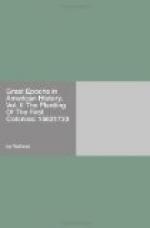John Van Corlear, with a few men, had been commissioned by Governor Van Twiller, and had put up a rude earthwork, with two guns, within the present jurisdiction of Hartford. His summons to Holmes to stop under penalty of being fired into met with no more respect than was shown by the commandant of Rensselaerswyck to his challengers, according to the veracious Knickerbocker. Holmes declared that he had been sent up the river, and was going up the river, and furthermore he went up the river. His little vessel passed on to the present site of Windsor. Here the crew disembarked, put up and garrisoned their trading house, and then returned home. Plymouth had at least planted the flag far within the coveted and disputed territory.
In December of the following year a Dutch force of seventy men from New Amsterdam appeared before the trading house to drive out the intruders. He must be strong who drives a Yankee away from a profitable trade; and the attitude of the little garrison was so determined that the Dutchmen, after a few hostile demonstrations, decided that the nut was too hard to crack, and withdrew. For about twenty years thereafter the Dutch held post at Hartford, isolated from Dutch support by a continually deepening mass of New Englanders, who refrained from hostilities, and waited until the apple was ripe enough to drop.
With respect to the claims of the Indians, the attitudes of the two parties to the struggle were directly opposite. The Dutch came on the strength of purchase from the Pequots, the conquerors and lords paramount of the local Indians. Holmes brought to the Connecticut River in his vessel the local sachems, who had been driven away by the Pequots, and made his purchases from them. The English policy will account for the unfriendly disposition of the Pequots, and, when followed up by the tremendous overthrow of the Pequots, for Connecticut’s permanent exemption from Indian difficulties. The Connecticut settlers followed a straight road, buying lands fairly from the Indians found in possession, ignoring those who claimed a supremacy based on violence, and, in ease of resistance by the latter, asserting and maintaining for Connecticut an exactly similar title,—the right of the stronger. Those who claimed right received it; those who preferred force were accommodated.
One route to the new territory by Long Island Sound and the Connecticut River, had thus been appropriated. The other, the overland route through Massachusetts, was explored during the same year, 1633, by one John Oldham, who was murdered by the Pequots two years afterward. He found his way westward to the Connecticut River, and brought back most appetizing accounts of the upper Connecticut Valley; and his reports seem to have suggested a way out of a serious difficulty which had come to a head in Massachusetts Bay.




